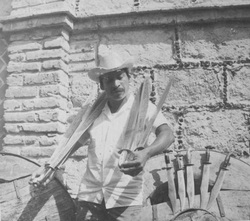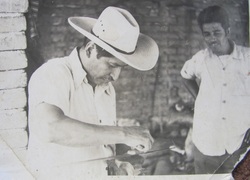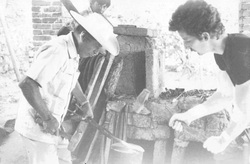D O N P R I M I T I V O

Don Primitivo at Tlapa market 1960's
"The Machete serves to cut the cane, to open paths in shadowed woods, to decapitate serpents, to cut down weeds, and to humble the pride of the impious rich." - Diego Rivera
In 1980, my friend, the Mexican fiber artist Yosi Anaya, invited me to come visit her and to meet Don Primitivo Pablo Romano, a machete maker she knew who lived in the mountains of the state of Guerrero. Yosi described his work in great detail and explained how it was recognized as being culturally important by the Mexican government.
I flew back to Mexico City with Yosi and stayed for a week with her and her mother. We traveled by overnight bus south to Guerrero and then a four-person single engine plane carried us up into the mountains……. There appeared to be nothing below, just dirt, trees and rocks. The pilot pulled what I thought was a logbook out from under his seat and opened it on the planes steering yoke. As I was sitting in the passenger seat up front, I looked over to see the log book was not a log book at all, but Jules Verne's Around the World in Eighty Days! The plane landed on a short grass landing strip that moments earlier had cattle grazing on it. We walked from there into the village of Cualac and started asking for Don Primitivo.
In 1980, my friend, the Mexican fiber artist Yosi Anaya, invited me to come visit her and to meet Don Primitivo Pablo Romano, a machete maker she knew who lived in the mountains of the state of Guerrero. Yosi described his work in great detail and explained how it was recognized as being culturally important by the Mexican government.
I flew back to Mexico City with Yosi and stayed for a week with her and her mother. We traveled by overnight bus south to Guerrero and then a four-person single engine plane carried us up into the mountains……. There appeared to be nothing below, just dirt, trees and rocks. The pilot pulled what I thought was a logbook out from under his seat and opened it on the planes steering yoke. As I was sitting in the passenger seat up front, I looked over to see the log book was not a log book at all, but Jules Verne's Around the World in Eighty Days! The plane landed on a short grass landing strip that moments earlier had cattle grazing on it. We walked from there into the village of Cualac and started asking for Don Primitivo.

Don Primitivo Engraving a Machete 1960's
_“Down the road and straight ahead.” Cualac was a very small village at that time. Electricity was not available through out the town, nor was municipal water or telephone. Don Primitivo answered our knock on his door and welcomed us warmly. We carried sleeping bags and had planned on camping out on his porch, but Don Primitivo insisted on putting up his guests properly. He took us to a stonewalled, thatched roof, dirt-floored restaurant/hotel in the center of the village. Inside there was a single picnic style table, un-husked corn heaped against the wall and chickens pecking at bugs. We were led to our room… a single small bed with a thatch mattress. There was a simple wooden table next to the bed with some candles, photographs and religious icons on it.
I don’t remember what we ate, but that we ate well. Sleep was another matter. The bed was flea ridden and all night long, people came into the room, knelt down at the table by the bed, and prayed. Apparently, someone in the family had died recently (in this very bed!) and the bedside table was used as an altar.
I don’t remember what we ate, but that we ate well. Sleep was another matter. The bed was flea ridden and all night long, people came into the room, knelt down at the table by the bed, and prayed. Apparently, someone in the family had died recently (in this very bed!) and the bedside table was used as an altar.

With Don Primitivo 1980
_Don Primitivo worked at his forge with his brother and young
son. His brother acted as a striker, following Don Primitivo’s small hammer
blows with a much larger sledge, while his son pumped the leather bellows of the
charcoal fired adobe forge. He was
using old leaf springs for the blades (a great blade steel, by the way) and cow
horn for the handles. Like
every other iron worker I have seen in Mexico, he was using something other
than a traditional blacksmiths anvil.
In this case what might have been a piece of railroad car axle. I wish that I had realized what I was
actually seeing and participating in while working with Don Primitivo, as this
was living history and would soon be gone. I look occasionally on Ebay for one of Don Primitivo's
machetes, but none has turned up. He was still making real working tools and
not the usual etched tourist pieces.

Machete by Don Primitivo Pablo Romano - British Museum Collection
In 2011 I was researching Mexican machetes and learned that Cualac, and some other towns in Guerrero are known for their machetes. I found that the town of Cualac has a website, and so asked a friend to call the municipal building and inquire about Don Primitivo. Si! Don Primitivo esta vivo! He's no longer making machetes though. His son still makes them on occasion and no one else in Cualac makes them anymore. A real tradgedy. I've written to Don Primitivo and am planning to visit him. Maybe I can help his son out with some sales/marketing and he can reestablish a tradition in Cualac! But that's another story. See Don Primitivo part dos... here
